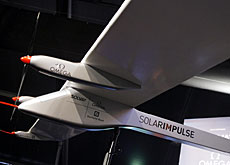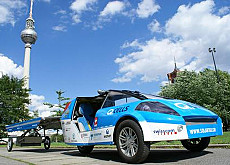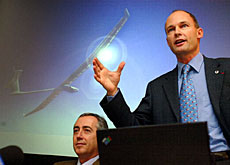Piccard unveils Solar Impulse prototype

The Swiss adventurer Bertrand Piccard has revealed the first model of his "Solar Impulse" plane in which he plans to fly around the world.
Speaking at Dübendorf military airport just outside Zurich, Piccard said the aim of the project was to demonstrate the role of renewable energy sources in sustainable development.
After four years of research, calculations and simulations, the Solar Impulse project has entered a concrete phase with the construction of an initial prototype with a 61-metre wingspan – the same as an Airbus A380.
If all the sums work, the plane could make a 36-hour flight – the equivalent of a complete day-night-day cycle – in 2009 without any fuel.
“Solar Impulse is not just a plane, but also a vision for a sustainable use of energy,” said 49-year-old Piccard on Monday. In 1999 he became the first man to circle the earth non-stop in the Breitling Orbiter 3 hot-air balloon.
Construction of the first prototype began in June 2007 and will last until the summer of 2008. Test flights should start in autumn 2008, with the aim of completing the first night flight in 2009.
Another plane will then be developed to attempt to fly several 24-hour cycles consecutively, leading to the first transatlantic flight in 2011 and then the first round-the-world flight.
Objectives
The prototype is basic – the instrument panel is reduced to the essentials and with a non-pressurised cockpit the 1.5-tonne aircraft will be unable to fly above 8,500m.
It will be a first approach at optimising the balance between energy consumption, weight, performance and controllability. The goal is not to try to fly around the world and indeed the prototype is not built to do so.
According to the Solar Impulse team, there are three objectives at this stage: first, to validate the computer simulation results, the technological choices and the construction techniques.
Second, to test an unexplored area of flight: never before has an airplane succeeded in flying with these size, weight and speed characteristics.
Third, to store sufficient solar energy during the daytime to demonstrate the feasibility of a day-night-day cycle (36-hour flight).
Specialists
To achieve this, a multi-disciplinary team of 50 specialists from six countries, based in Dübendorf and Lausanne, assisted by a further hundred outside advisers, are pooling their very specific experience and knowledge.
Research initiatives have been undertaken in a number of sectors: conception, aerodynamics, energy efficiency, structure, composite materials and manufacturing procedures – both for individual components and for the assembly as a whole.
Piccard, the initiator and president of the project, says the Solar Impulse is the symbol of the new technologies that society ought to be capable of rallying behind in order to economise the planet’s energy resources.
swissinfo with agencies
Bertrand Piccard and Brian Jones were the first to circle the earth non-stop in a hot-air balloon, the Breitling Orbiter 3, in 1999.
He is a psychoanalyst and comes from a family of famous scientists.
His grandfather, Auguste, was immortalised by cartoonist Hergé as Professor Calculus and he invented the principle of the pressurised airline cabin.
Piccard’s father, Jacques, became famous in 1960 for reaching the deepest point surveyed in the oceans, Challenger Deep, 10,923 metres below the surface in the Mariana Trench in the Pacific.
While Piccard’s flight would be a first, other groups have already attempted solar-powered flight.
Nasa achieved success in 1997 when its Pathfinder—a lightweight, unmanned, flying wing—built with the AeroVironment firm climbed to 21,793 metres under its own power.
In 2001 the remotely piloted Helios aircraft reached an altitude of 29,524 metres —an unofficial world-record altitude flight for a solar plane. During a 2003 flight, Helios crashed near Hawaii.
The first really notable solar aircraft was AeroVironment’s Solar Challenger, which crossed the English Channel in July 1981.

In compliance with the JTI standards
More: SWI swissinfo.ch certified by the Journalism Trust Initiative



You can find an overview of ongoing debates with our journalists here. Please join us!
If you want to start a conversation about a topic raised in this article or want to report factual errors, email us at english@swissinfo.ch.